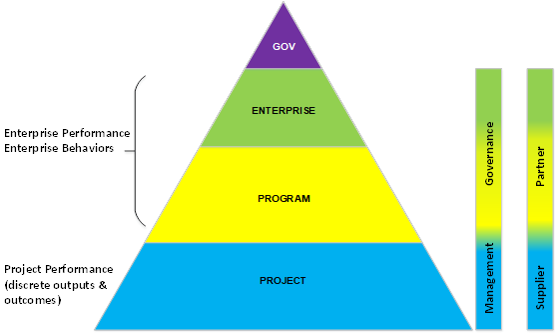SECOND EDITION
By Bob Prieto
Jupiter, Florida, USA
In the engineering and construction industry governance needs and requirements exist at multiple levels. These include:
- Governmental and industry level governance (laws, regulations, codes, standards)
- Enterprise level (encompassing social (stakeholder), political, economic (market, shareholder, financial institutions), cultural (corporate and national/local), technological)
- Portfolio and programs
- Project
This paper focuses on the portfolio and program level, collectively referred to as program in this paper.

Enterprise level portfolio and program management in the engineering and construction industry represents a fundamental re-allocation of responsibilities and authorities between the traditional owner organization and an engaged program manager. The program management function can be viewed as consisting of two discrete elements:
- An enterprise level program management oversight function[1]
- A program management office/contractor
The readiness of the owner organization to adopt such a delivery strategy and execution approach is governed by many factors including:
- overall capital project delivery volumes
- prior experience, if any, with portfolio and program management delivery approaches
- inherent organizational capabilities and depth of staff
- degree of recognition of the level of self-change that adoption of a different delivery and management methodology requires
From the program manager’s perspective, a key factor for success will be the degree to which its responsibilities can be clearly defined and responsibility and authority allocated consistent with these responsibilities and the owner organization’s own readiness. Well developed contractual and implementation frameworks are therefore key ingredients for success but in many cases, even the best developed frameworks are undermined by a poorly defined governance regime and inadequate contract administration capabilities within owner organizations. This later factor sometimes reflects passive resistance to change while in other instances it reflects inadequate organizational maturity to adopt the new delivery regime.
This paper is not intended to dwell on the failings of either the program management or broader owner organizations but rather outline some of the governance features which are hallmarks of successful portfolio and program management implementations.
Governance Thinking
Governance thinking associated with the delivery of large complex capital project portfolios and programs has developed across a wide range of industries ranging from government implemented healthcare transformations to enterprise wide IT delivery efforts. In the engineering & construction industry, attention to governance issues at the outset of program initiation has been to a large degree spotty and inconsistent. The evolving nature of programs delivered in the engineering & construction industry and, more importantly, the inherent risks that program manager’s increasingly face give rise to a necessary refocusing on governance issues. The engineering & construction industry can, however, draw not only on its own experience but on that of other sectors as well.
More…
To read entire article, click here
How to cite this paper: Prieto, R. (2020). Governance of Mega and Giga Programs, PM World Journal, Vol. IX, Issue VII, July. Available online at https://pmworldlibrary.net/wp-content/uploads/2020/06/pmwj95-Jul2020-Prieto-governance-of-mega-and-giga-programs.pdf
About the Author

Bob Prieto
Chairman & CEO
Strategic Program Management LLC
Jupiter, Florida, USA
![]()
Bob Prieto is a senior executive effective in shaping and executing business strategy and a recognized leader within the infrastructure, engineering and construction industries. Currently Bob heads his own management consulting practice, Strategic Program Management LLC. He previously served as a senior vice president of Fluor, one of the largest engineering and construction companies in the world. He focuses on the development and delivery of large, complex projects worldwide and consults with owners across all market sectors in the development of programmatic delivery strategies. He is author of nine books including “Strategic Program Management”, “The Giga Factor: Program Management in the Engineering and Construction Industry”, “Application of Life Cycle Analysis in the Capital Assets Industry”, “Capital Efficiency: Pull All the Levers” and, most recently, “Theory of Management of Large Complex Projects” published by the Construction Management Association of America (CMAA) as well as over 700 other papers and presentations.
Bob is an Independent Member of the Shareholder Committee of Mott MacDonald. He is a member of the ASCE Industry Leaders Council, National Academy of Construction, a Fellow of the Construction Management Association of America and member of several university departmental and campus advisory boards. Bob served until 2006 as a U.S. presidential appointee to the Asia Pacific Economic Cooperation (APEC) Business Advisory Council (ABAC), working with U.S. and Asia-Pacific business leaders to shape the framework for trade and economic growth. He had previously served as both as Chairman of the Engineering and Construction Governors of the World Economic Forum and co-chair of the infrastructure task force formed after September 11th by the New York City Chamber of Commerce. Previously, he served as Chairman at Parsons Brinckerhoff (PB) and a non-executive director of Cardno (ASX)
Bob can be contacted at rpstrategic@comcast.net.
To view other works by Bob Prieto, visit his author showcase in the PM World Library at https://pmworldlibrary.net/authors/bob-prieto/
[1] The program management office or PMO is not explicitly covered in this paper but among its responsibilities are management and oversight of the tollgate process and what I refer to as strategic audit. Appendix 1 contains a sample strategic audit checklist for a PMO in a mega transportation program.









